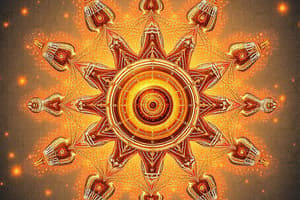Podcast
Questions and Answers
What particle in an atom is positively charged?
What particle in an atom is positively charged?
- Neutron
- Photon
- Proton (correct)
- Electron
Neutrons carry a positive charge.
Neutrons carry a positive charge.
False (B)
Define isotopes.
Define isotopes.
Isotopes are atoms of the same element with the same number of protons but different numbers of neutrons.
The atomic number of an element is determined by the number of ______ in its nucleus.
The atomic number of an element is determined by the number of ______ in its nucleus.
Match the following subatomic particles with their charges:
Match the following subatomic particles with their charges:
Which shell can hold a maximum of two electrons?
Which shell can hold a maximum of two electrons?
The atomic mass is an average mass of all isotopes of an element.
The atomic mass is an average mass of all isotopes of an element.
What do you call the electrons in the outermost shell of an atom?
What do you call the electrons in the outermost shell of an atom?
Flashcards
What are protons?
What are protons?
The positively charged particles located in the atomic nucleus.
What are neutrons?
What are neutrons?
Neutral particles found in the atomic nucleus.
What are electrons?
What are electrons?
Negatively charged particles that orbit the nucleus in specific energy levels.
What is the atomic number?
What is the atomic number?
Signup and view all the flashcards
What is the mass number?
What is the mass number?
Signup and view all the flashcards
What are isotopes?
What are isotopes?
Signup and view all the flashcards
What is the nucleus?
What is the nucleus?
Signup and view all the flashcards
What are valence electrons?
What are valence electrons?
Signup and view all the flashcards
Study Notes
Subatomic Particles
- Atoms are composed of three fundamental subatomic particles: protons, neutrons, and electrons.
- Protons are positively charged particles located in the nucleus of the atom.
- Neutrons are neutral (uncharged) particles also found in the atomic nucleus.
- Electrons are negatively charged particles that orbit the nucleus in specific energy levels or shells.
Atomic Number and Mass Number
- The atomic number of an element is the number of protons in the nucleus of an atom of that element. It uniquely identifies the element.
- The mass number of an atom is the sum of the number of protons and neutrons in its nucleus.
Isotopes
- Isotopes are atoms of the same element that have the same number of protons but different numbers of neutrons.
- This difference in the number of neutrons leads to different mass numbers for isotopes of the same element.
- Isotopes exhibit similar chemical properties but slightly different physical properties.
Atomic Structure
- The nucleus, containing protons and neutrons, is tiny compared to the overall size of the atom.
- The vast majority of an atom's volume is occupied by the space occupied by electrons.
- Electrons orbit the nucleus in specific energy levels or electron shells.
- These shells are arranged at increasing distances from the nucleus.
- Each shell has a maximum number of electrons it can hold.
- The innermost shell can hold a maximum of two electrons. Outer shells can hold more.
- Electrons in the outermost shell are called valence electrons and play a crucial role in chemical bonding.
Models of the Atom
- Early models of the atom included the plum pudding model and the planetary model.
- The modern model describes electrons as occupying orbitals, which are regions of space where there is a high probability of finding an electron.
- These orbitals are often shown as clouds, representing the electron's probable location instead of a fixed path.
- Different shapes and sizes exist with different degrees of electron probability, leading to various energy level and orbital structures.
Atomic Mass
- The atomic mass of an element is the average mass of all the naturally occurring isotopes of that element, taking into account their abundance.
- It is usually expressed in atomic mass units (amu) or grams per mole (g/mol).
- The amu is defined as one-twelfth the mass of a carbon-12 atom.
Electron Configuration
- The electron configuration of an atom describes how electrons are arranged in the different energy levels and orbitals.
- This arrangement is governed by specific rules and principles.
- For example, the Aufbau principle dictates that electrons fill the lowest energy levels first.
Ionization
- An ion is an atom or molecule that has gained or lost one or more electrons, resulting in a net electrical charge.
- Atoms that lose electrons become positively charged ions (cations).
- Atoms that gain electrons become negatively charged ions (anions).
Studying That Suits You
Use AI to generate personalized quizzes and flashcards to suit your learning preferences.




